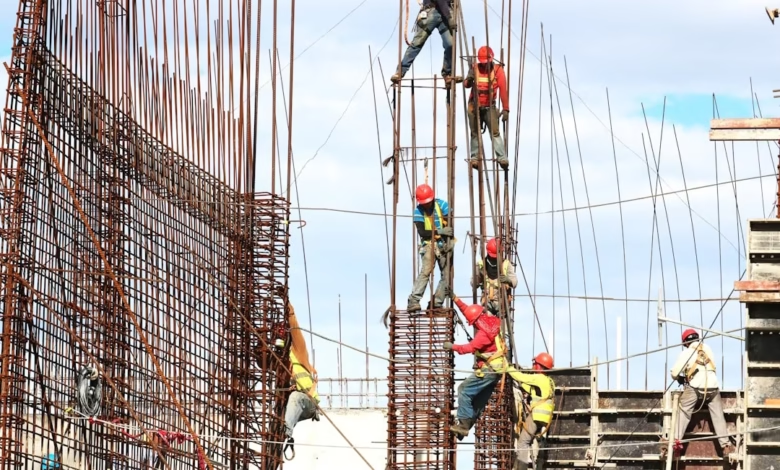Navigating the Future of Construction Metals: The Impact of Steel, Aluminum, and Metal Trends on Sustainable Building Practices

In the ever-evolving landscape of construction, the significance of metals cannot be overstated. From the robust strength of steel to the lightweight versatility of aluminum, construction metals form the backbone of modern architecture and infrastructure. As the industry shifts towards sustainable practices and innovative technologies, understanding the role of both ferrous and non-ferrous metals is crucial. This article delves into the essential contributions of various metals, including precious metals like gold and silver, and industrial metals such as copper, zinc, and lithium, in building materials. We will explore the current trends in metallurgy, emphasizing sustainable metal production and recycling efforts that are reshaping the construction sector. Additionally, we will examine how advancements in metal fabrication and 3D printing are paving the way for the future of construction materials. Join us as we uncover the dynamic world of construction metals and their pivotal role in addressing modern challenges while driving innovation in the industry.
- 1. The Role of Ferrous and Non-Ferrous Metals in Modern Construction: Steel, Aluminum, and Beyond
- 2. Sustainable Metal Production and Recycling: Innovations in Metal Fabrication for the Construction Industry
- 3. Exploring Metal Trends: How Industrial Metals and Alloys Shape the Future of Building Materials
1. The Role of Ferrous and Non-Ferrous Metals in Modern Construction: Steel, Aluminum, and Beyond
In modern construction, the choice of materials significantly influences the durability, efficiency, and sustainability of buildings. Ferrous and non-ferrous metals play crucial roles in this sector, with steel and aluminum being the most prominent examples.
Ferrous metals, primarily composed of iron, are known for their strength and durability, making them essential in structural applications. Steel, a key ferrous metal alloy, is often used in beams, columns, and reinforcements due to its high tensile strength and versatility. The demand for steel in construction continues to grow, driven by the ongoing urbanization and infrastructure development across the globe. Additionally, advancements in metallurgy have resulted in the creation of high-strength steel grades that offer enhanced performance while being lighter, which helps reduce overall construction costs and carbon footprint.
On the other hand, non-ferrous metals, such as aluminum and copper, provide unique advantages in construction. Aluminum is prized for its lightweight properties, resistance to corrosion, and recyclability, making it an ideal choice for facades, roofing, and window frames. Furthermore, the rise of sustainable metal production practices has made aluminum even more appealing, as it can be recycled indefinitely without losing quality. Copper, another non-ferrous metal, is often used in electrical systems and plumbing due to its excellent conductivity and resistance to corrosion.
The role of industrial metals extends beyond just steel and aluminum; other metals like zinc, lithium, and even precious metals like gold and silver are increasingly being integrated into construction projects. Zinc, for instance, is used in galvanization processes to protect steel from corrosion, enhancing the longevity of structures. Meanwhile, lithium and other battery metals are becoming more relevant in the context of sustainable energy solutions, as the construction industry shifts toward integrating renewable energy sources into buildings.
Moreover, metal recycling plays a critical role in promoting sustainability within the construction sector. By reusing base metals and rare earth metals, the industry can significantly reduce waste and the environmental impact associated with metal mining. The evolving landscape of metal trends includes a focus on 3D printing metals, which allows for innovative design solutions and reduces material waste, further contributing to sustainable practices in construction.
In summary, the strategic use of ferrous and non-ferrous metals in modern construction not only enhances the performance and aesthetics of buildings but also aligns with the growing emphasis on sustainability and responsible resource management. As the industry continues to evolve, understanding the properties and applications of various metals, including aerospace metals and automotive metals, will be crucial for developers and builders aiming to stay ahead in a competitive market.
2. Sustainable Metal Production and Recycling: Innovations in Metal Fabrication for the Construction Industry
Sustainable metal production and recycling have become pivotal in the construction industry, particularly as the demand for eco-friendly building materials continues to grow. Innovations in metal fabrication not only enhance the efficiency of construction metals like steel and aluminum but also significantly reduce the environmental impact associated with metal mining and metallurgy.
One of the key trends in sustainable metal production is the increased use of recycled materials. Metal recycling has gained traction as a viable solution to minimize waste and lower the carbon footprint of construction projects. By repurposing ferrous and non-ferrous metals such as copper, zinc, and aluminum, construction companies can conserve resources and reduce the need for new metal commodities. In fact, recycling metals can save up to 95% of the energy required to produce new metals from raw materials, making it a crucial component of sustainable practices.
Moreover, advancements in 3D printing metals are revolutionizing the way construction components are fabricated. This technology allows for the precise production of metal alloys with reduced waste and enhanced design flexibility. By utilizing base metals in 3D printing, manufacturers can create complex structures that are not only lightweight but also strong and durable, effectively addressing issues like metal corrosion and increasing the longevity of building materials.
Another innovation is the development of energy metals, such as lithium and cobalt, which are finding applications beyond traditional construction. These materials are essential for producing energy-efficient systems in buildings, such as solar panels and battery storage solutions. By incorporating these energy metals into construction designs, builders can create structures that are not only sustainable but also capable of harnessing renewable energy sources.
In addition, the focus on precious metals like platinum and palladium in construction and high-performance applications is growing. These refractory metals are prized for their resistance to heat and corrosion, making them suitable for specialized applications in the aerospace and automotive industries. As such, their inclusion in construction materials is an example of how the industry can leverage advanced metallurgy to enhance product performance while adhering to sustainable production methods.
Ultimately, the integration of innovative metal fabrication techniques in the construction industry is not just a trend; it represents a critical shift toward sustainability. By prioritizing metal recycling, embracing new technologies like 3D printing, and utilizing energy and aerospace metals, the construction sector can significantly contribute to a more sustainable future. As we move forward, the importance of sustainable metal production will only increase, shaping the way we build and interact with our environments.
3. Exploring Metal Trends: How Industrial Metals and Alloys Shape the Future of Building Materials
The construction industry is experiencing a significant transformation driven by advancements in metallurgy and a growing emphasis on sustainability. As we explore metal trends that shape the future of building materials, it's essential to consider both industrial metals and metal alloys that offer enhanced properties for construction applications.
Industrial metals such as steel, aluminum, and copper are at the forefront of this evolution. Steel, a ferrous metal known for its strength, remains a staple in construction. Its durability and versatility make it an ideal choice for structural applications, while aluminum, a non-ferrous metal, is increasingly favored for its lightweight nature and resistance to corrosion. These metals are not only essential for traditional building methods but are also becoming key components in innovative practices like 3D printing metals, which allow for complex designs and reduced waste.
The trend towards sustainable metal production is reshaping the approach to construction metals. As awareness of environmental impacts grows, metal recycling has become crucial in minimizing waste and conserving natural resources. The recycling of base metals such as aluminum and copper not only reduces the need for metal mining but also lowers energy consumption and emissions associated with metal fabrication. This circular economy approach emphasizes the importance of using recycled materials in building projects, aligning with global sustainability goals.
Moreover, the integration of rare earth metals and precious metals like gold and platinum is gaining traction in specialized construction applications, particularly in aerospace and automotive sectors. These metals, known for their unique properties, are being used to enhance performance in energy-efficient designs and advanced technologies. For instance, lithium, a key battery metal, plays a pivotal role in the development of energy-efficient systems in modern buildings.
As the construction industry continues to innovate, understanding the dynamics of metal commodities will be critical. Gold investing and silver investing, traditionally seen as safe havens, are also influencing market trends in metals, affecting availability and pricing. With the rise of metal corrosion resistance technologies and the demand for refractory metals in high-temperature applications, the future of construction metals looks promising.
In conclusion, the interplay of industrial metals, metal alloys, and emerging trends in metallurgy is set to redefine building materials. By embracing sustainable practices and innovative applications, the construction industry can not only meet current demands but also pave the way for a more resilient and environmentally-friendly future.
In conclusion, the landscape of construction metals is rapidly evolving, driven by innovations in metallurgy and sustainable practices. As we have explored, both ferrous and non-ferrous metals, including steel and aluminum, play crucial roles in modern construction, thanks to their strength, versatility, and adaptability. The push for sustainable metal production and recycling is transforming the industry, with advancements in metal fabrication paving the way for greener building practices.
Moreover, the trends in industrial metals and alloys are shaping the future of construction materials, with emerging technologies like 3D printing metals offering new possibilities for efficiency and design. As we look ahead, the significance of base metals, precious metals, and even rare earth metals in various applications—from automotive to aerospace—will continue to grow.
Investing in metals such as lithium, platinum, and palladium not only supports the construction sector but also contributes to a broader focus on sustainability and resource efficiency. By embracing these metal trends, the construction industry can enhance its resilience against challenges like metal corrosion and resource scarcity. Ultimately, the future of construction metals is not only about building structures but also about building a sustainable world.
References:
– [Insert relevant references here]





